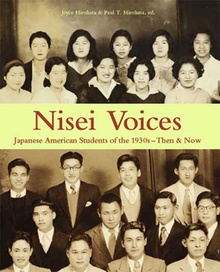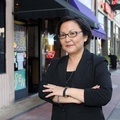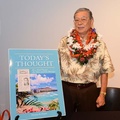In the 1930s Paul T. Hirohata gathered copies of speeches given by forty-nine Nisei valedictorians and published them in a collection called Orations and Essays. Seventy years later, his granddaughter, Joyce Hirohata reviewed the book, this time from an adult perspective, and it “took over her imagination.”
By her calculations, Ms. Hirohata realized that many of the students would have been part of the incarceration of Japanese Americans during World War II, and many, although elderly, would still be alive. She began to wonder what had become of them, and thus, her journey to create Nisei Voices: Japanese American Students of the 1930s—Then & Now began.
Joyce Hirohata’s original intention was to retype and reprint the worn copy of Orations and Essays as requested by her father. However, the project quickly evolved into something more. By using various means to locate and contact these valedictorians, she first collected pictures and decided to include them with the speeches. Then, when she heard their stories, she made additional plans to include a biographical piece with each of the speeches.
At this point in her work, however, the book still seemed to lack something. If the speeches had been published with pictures and biographical information, the result would have been more of an anthology. It simply didn’t seem to capture the emotional, human side of the story; it didn’t seem to reveal what these Japanese Americans went through collectively. Hirohata wanted the new edition of the book to pique the interest of people much like herself who don’t ordinarily find history a personal subject of interest. She wanted to hook readers into the emotion and drama of the experience, making the material more accessible while preserving the integrity of the original material.
After years of work, Nisei Voices in its revised form is divided into two parts—the first part consisting of a biographical narrative focusing on the lives of the students as a group and the second part containing the text of the graduation speeches that are now grouped by topics.
While working on this project, Hirohata found herself struck by the ironies inherent in so many of the stories. For example, Jimmy Hamasaki, born in California, moved to Taiwan to work for the United States Consulate before the war, and when Pearl Harbor broke out, he was placed under house arrest by the Japanese. Later, as part of the first diplomatic exchange between the U.S. and Japan, he and his wife Clara returned, only to find that he was again looked upon with suspicion by the U.S. government and detained on Ellis Island. He was also denied permission to visit his parents in Arizona.
In addition to these stories, there were also surprisingly uplifting stories that arose from the research for Nisei Voices. It was discovered that Helen Kuwada and Frank Yamakoshi initially met because of the first book. Frank was helping to collect speeches for the second edition and happened to ask Helen for her speech. Through this connection, they later fell in love, got married, and had five daughters. The author delights in talking about the couple’s story, calling it “incredibly touching, poignant, neat, that the book brought these two people together. It’s part of the romance amidst all of the pain and darkness of that period—something positive and something beautiful that came out of such a depressing period of U.S. history.”
The result of Joyce Hirohata’s ambitious project is a new edition of the book. Although her family had not been part of the internment, the author is able to convey a deep sense of empathy toward the Japanese Americans who were among those placed in camps. More importantly, she captures both the reality and complexity of the experience. Some of the students expressed anger and disappointment; others admitted being too young to truly understand the implications of the experience. The range of candid responses included in the book simply underscores the significance of her work.
As she states in the Preface of Nisei Voices, Joyce Hirohata wants “this book to serve as a reminder to never repeat the racist times and hysteria that led to the expulsion and incarceration of people of Japanese heritage during World War II.” Reflecting on her own experience of “reliving” this period of history with the Japanese Americans with whom she spoke, Hirohata comments, “I know that I didn’t go through it in the way that they did, but in a funny way, I went through it in my own way.” Readers will undoubtedly share that sentiment and feel a unique connection to the students featured in the book. Nisei Voices: Japanese American Students of the 1930s—Then & Now is a lasting tribute to the memory of the author’s grandfather as well as a generation of Japanese Americans who overcame a period of profound injustice. Through this “labor of love,’ Joyce Hirohata has also become a noteworthy “voice” of her generation.
* This article was originally published on the Japanese American National Museum Store Online in 2004.
© 2004 Japanese American National Museum







